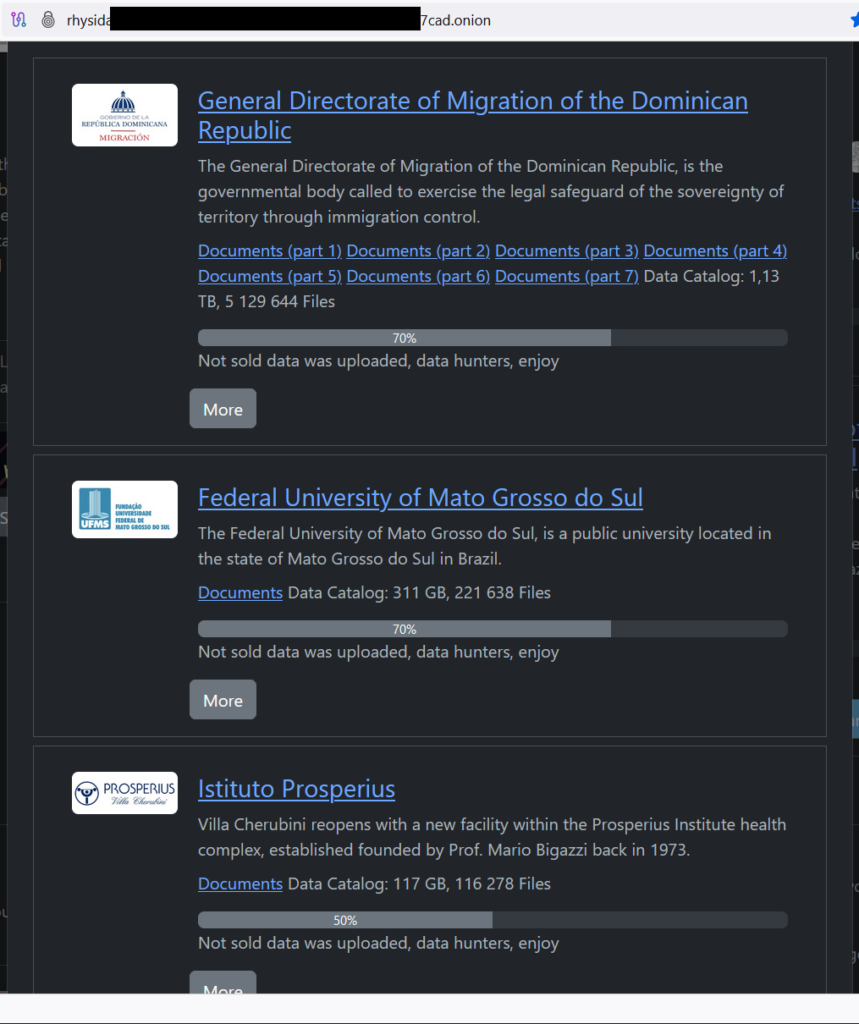Rhysida is a new ransomware strain that emerged in the second quarter of 2023. The first mention of the Rhysida ransomware was in May 2023 by MalwareHunterTeam (sample’s timestamp is May 16, 2023). As of Oct 12, the ransomware’s leak site contains a list of over 50 attacked organizations of all types, including government, healthcare, and IT.

Victims of the Rhysida ransomware can contact Avast experts directly at decryptors-at-avast-dot-com for a free consultation about how to mitigate damage caused by the attack.
Analysis of the Rhysida encryptor
The Rhysida encryptor comes as a 32-bit or 64-bit Windows PE file, compiled by MinGW GNU version 6.3.0 and linked by the GNU linker v 2.30. The first public version comes as a debug version, which makes its analysis easier.
For cryptographic operations, Rhysida uses the LibTomCrypt library version 1.18.1. For multi-threaded and synchronization operations, Rhysida uses the winpthreads library. Chacha20 pseudo-random number generator is used for generating random numbers, such as AES encryption key, AES initialization vector and random padding for RSA-OAEP encryption. The public RSA key is hard-coded in the binary (ASN1-encoded) and loaded using the rsa_import function. Each sample has different embedded RSA key.
The encryptor executable supports the following command line arguments:
-dSpecifies a directory name to encrypt. If omitted, all drives (identified by letters) are encrypted-srEnables self-remove after file encryption-nobgDisables setting desktop background-SWhen present, Rhysida will create a scheduled task, executing at OS startup under the System account-md5When present, Rhysida will calculate MD5 hash of each file before it is encrypted. However, this feature is not fully implemented yet – the MD5 is calculated, but it’s not used anywhere later.
When executed, the encryptor queries the number of processors in the system. This value serves for:
- Allocating random number generators (one per processor)
- Creating
Encryptorthreads (one per processor)

Furthermore, Rhysida creates a File Enumerator thread, which searches all available disk drives by letter. Binaries prior July 2023 enumerate drives in normal order (from A: to Z:); binaries built after July 1st enumerate drives in reverse order (from Z: to A:).
The File Enumerator thread searches for files to encrypt and puts them into a synchronized list, ready to be picked by one of the Encryptor threads. Files in system critical folders, and files necessary to run operating systems and programs, are excluded from encryption.
List of skipped directories:
- /$Recycle.Bin
- /Boot
- /Documents and Settings
- /PerfLogs
- /Program Files
- /Program Files (x86)
- /ProgramData
- /Recovery
- /System Volume Information
- /Windows
- /$RECYCLE.BIN
List of skipped file types:
- .bat
- .bin
- .cab
- .cd
- .com
- .cur
- .dagaba
- .diagcfg
- .diagpkg
- .drv
- .dll
- .exe
- .hlp
- .hta
- .ico
- .lnk
- .msi
- .ocx
- .ps1
- .psm1
- .scr
- .sys
- .ini
- Thumbs.db
- .url
- .iso
Additionally, the ransom note file, usually named CriticalBreachDetected.pdf, is excluded from the list of encrypted files. The PDF content of the ransom note file is hard-coded in the binary and is dropped into each folder. The following picture shows an example of the ransom note from a September version of the ransomware:

In addition to dropping the ransom note, if enabled in the configuration, Rhysida generates a JPEG picture, which is stored into C:/Users/Public/bg.jpg. Earlier version of the ransomware generated the image with unwanted artifacts, which was fixed in later builds of Rhysida. The following picture shows an example of such JPEG pictures:

The picture is set as the desktop background on the infected device. For that purpose, a set of calls to an external process via system (a C equivalent of CreateProcess) is used:

Rhysida may or may not (depending on the configuration and binary version) execute additional actions, including:
- Delete shadow copies using:
cmd.exe /c vssadmin.exe Delete Shadows /All /Quiet
- Delete the event logs with this command:
cmd.exe /c for /F "tokens=*" %1 in ('wevtutil.exe el') DO wevtutil.exe cl "%1"
- Delete itself via Powershell command
cmd.exe /c start powershell.exe -WindowStyle Hidden -Command Sleep -Milliseconds 500; Remove-Item -Force -Path "%BINARY_NAME%” -ErrorAction SilentlyContinue;
- (Re-)create scheduled task on Windows startup:
cmd.exe /c start powershell.exe -WindowStyle Hidden -Command “Sleep -Milliseconds 1000; schtasks /end /tn Rhsd; schtasks /delete /tn Rhsd /f; schtasks /create /sc ONSTART /tn Rhsd /tr \”
- Remove scheduled task using:
cmd.exe /c start powershell.exe -WindowStyle Hidden -Command "Sleep -Milliseconds 1000; schtasks /delete /tn Rhsd /f;"
How Rhysida encrypts files
To achieve the highest possible encryption speed, Rhysida’s encryption is performed by multiple Encryptor threads. Files bigger than 1 MB (1048576 bytes) are divided to 2-4 blocks and only 1 MB of data is encrypted from each block. The following table shows an overview of the number of blocks, size of one block and length of the encrypted part:
| File Size | Block Count | Block Size | Encrypted Length |
| 0 – 1 MB | 1 | (whole file) | (whole block) |
| 1 – 2 MB | 1 | (whole file) | 1048576 |
| 2 – 3 MB | 2 | File Size / 2 | 1048576 |
| 3 – 4 MB | 3 | File Size / 3 | 1048576 |
| > 4MB | 4 | File Size / 4 | 1048576 |
Multiple steps are performed to encrypt a file:
- The file is renamed to have the “.rhysida” extension.
- The file size is obtained by the sequence below. Note that earlier versions of the ransomware contain a bug, which causes the upper 32 bits of the file size to be ignored. In later versions of Rhysida, this bug is fixed.

- Based on the file size, Rhysida calculates counts and length shown in Table 1.
- 32-byte file encryption key and 16-byte initialization vector for AES-256 stream cipher is generated using the random number generator associated with the
Encryptorthread. - Files are encrypted using AES-256 in CTR mode.
- Both file encryption key and the IV are encrypted by RSA-4096 with OAEP padding and stored to the file tail structure.
- This file tail is appended to the end of the encrypted file:

Conclusion
Rhysida is a relatively new ransomware, but already has a long list of attacked organizations. As of October 2023, it is still in an active development.
Victims of the Rhysida ransomware may contact us at decryptors-at-avast-dot-com for a consultation about how to mitigate damage caused by the attack.




